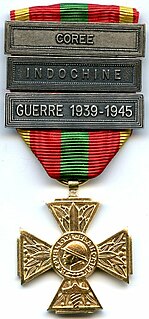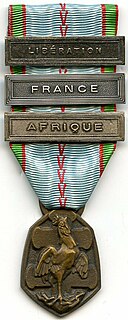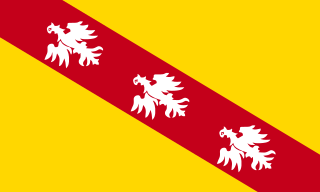
Marie-Pierre Kœnig was a French army officer and politician. He commanded a Free French Brigade at the Battle of Bir Hakeim in North Africa in 1942.

The French Forces of the Interior refers to French resistance fighters in the later stages of World War II. Charles de Gaulle used it as a formal name for the resistance fighters. The change in designation of these groups to FFI occurred as France's status changed from that of an occupied nation to one of a nation being liberated by the Allied armies. As regions of France were liberated, the FFI were more formally organized into light infantry units and served as a valuable manpower addition to regular Free French forces. In this role, the FFI units manned less active areas of the front lines, allowing regular French army units to practice economy of force measures and mass their troops in decisive areas of the front. Finally, from October 1944 and with the greater part of France liberated, the FFI units were amalgamated into the French regular forces continuing the fight on the Western Front, thus ending the era of the French irregulars in World War II.

The Escapees' Medal is a military award bestowed by the government of France to individuals who were prisoners of war and who successfully escaped internment or died as a result of their escape attempt. The "Escapees' Medal" was established by a 1926 law, intended to honour combatants not only of the First World War, but also of the Franco-Prussian War of 1870. Its statute was later amended to include combatants of the Second World War and later conflicts.
Philippe Ragueneau was a French journalist and writer. He was born in Orléans (Loiret) and died in Gordes (Vaucluse). Ragueneau was a resistance and then military fighter during World War II, and friend of the General Charles de Gaulle.
Jean Grelaud was, at age 108, one of the last three "poilus" or official French veterans of the First World War. He died at the age of 108 years and 122 days.
The Croix de guerre 1914–1918 is a French military decoration, the first version of the Croix de guerre. It was created to recognize French and allied soldiers who were cited for valorous service during World War I, similar to the British mentioned in dispatches but with multiple degrees equivalent to other nations' decorations for courage.
This is a list of the ribbons of the French military and civil awards.
The Croix du combattant volontaire may refer to one of three French military decorations rewarding soldiers who spontaneously chose to serve with a fighting unit.
Pierre Garbay was a French Army General.
Pierre Arpaillange was a French author, senior judge and Government Minister.

The Volunteer combatant's cross 1914–1918 is a French decoration that recognizes those who have volunteered to serve on the front in a combat unit during World War I. When the 1914–1918 Commemorative war medal (France) was established, it was anticipated that a clasp bearing "ENGAGÉ VOLONTAIRE" would be worn on its ribbon for those who had freely and voluntarily enlisted in the French Armed Forces for combat service. This clasp was produced, however it was short lived due to parliament demanding the establishment of a special insignia to distinguish the special merit of the voluntary combatant.

The 1914–1918 Commemorative war medal was awarded to soldiers and sailors for service in World War I. It was also awarded to civilians who met certain requirements. Created by Act of June 23, 1920, is awarded to any military member for service between 2 August 1914 and November 11, 1918. It is also given to civilians who served in the same period in the army or the Interior.

The Volunteer combatant's cross was a French decoration that originally recognized those who volunteered to serve in a combat unit during World War II. It is the equivalent of the "1914–1918 Volunteer combatant's cross".

The Combatant's Cross is a French decoration that recognizes, as its name implies, those who fought in combat for France. The Poilus of World War I worked toward recognition by the government, of a special status to those who had participated in the bitter fighting of 1914-1918. The law of 19 December 1926 created la "carte du combatant", or combatant's card, for veterans of 1914-1918, as well as for the veterans of 1870-1871 and colonial wars before the First World War. The decoration was created only three years later by the law of 28 June 1930.

The Médaille de la Gendarmerie nationale is a French military decoration created on 5 September 1949 on proposition of the then Minister of Defence, mister Paul Ramadier. It was originally created in a single grade for award to officiers and NCOs of the Gendarmerie nationale who were cited in the orders of the entire service. Such a citation in the orders of the entire service, and all potential subsequent ones would be denoted by a grenade device on the ribbon as the medal could, and can still only be awarded once to any potential recipient. The medal could also be exceptionally awarded to persons not members of the service for important services rendered to the gendarmerie or for help during special missions. These presentations were made without a citation and thus without any ribbon device.

The Medal for voluntary military service is a French military decoration established on 13 March 1975 by decree 75-150. It was established in three grades to recognize voluntary military service in the reserves.

The Croix de guerre (French) or Oorlogskruis (Dutch), both literally translating as "War Cross", is a military decoration of the Kingdom of Belgium established by royal decree on 25 October 1915. It was primarily awarded for bravery or other military virtue on the battlefield. The award was reestablished on 20 July 1940 by the Belgian government in exile for recognition of bravery and military virtue during World War II. The post-1940 decoration could also be awarded to units that were cited. The decoration was again reestablished by royal decree on 3 April 1954 for award during future conflicts.

The 1939–1945 Commemorative war medal is a commemorative medal of France established on 21 May 1946 to recognize individual participation in the Second World War.

In 1833, following the end of the Belgian Revolution, the young kingdom of Belgium created the Iron Cross to recognise wounds received and bravery in battle. The award first class was bestowed to the wounded who elected to stay at their post and keep fighting, to the maimed and mutilated, as well as for acts of courage, the award second class was bestowed to all wounded combatants. In 1835, due to the discontent of most recipients, the award 2nd class was terminated and all received the first class. Over the years, recipients of the Iron Cross received ever increasing pensions, up to ten years of seniority when employed as civil servants and pensions for the widows and orphans of the deceased. The other combatants of 1830-1831 received no pension, and no commemorative medal was struck.

The law of August 22, 1950, establishing the status of “recusant”, stated in its first article: "The Republic, grateful to those who accepted all the risks in their fight against the enemy's war potential, considering the suffering and the prejudice that this courageous and patriotic attitude caused them, proclaimed and determined the right to reparation for recusants and their successors.





















